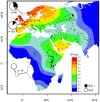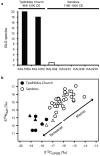Direct evidence of milk consumption from ancient human dental calculus
- PMID: 25429530
- PMCID: PMC4245811
- DOI: 10.1038/srep07104
Direct evidence of milk consumption from ancient human dental calculus
Abstract
Milk is a major food of global economic importance, and its consumption is regarded as a classic example of gene-culture evolution. Humans have exploited animal milk as a food resource for at least 8500 years, but the origins, spread, and scale of dairying remain poorly understood. Indirect lines of evidence, such as lipid isotopic ratios of pottery residues, faunal mortality profiles, and lactase persistence allele frequencies, provide a partial picture of this process; however, in order to understand how, where, and when humans consumed milk products, it is necessary to link evidence of consumption directly to individuals and their dairy livestock. Here we report the first direct evidence of milk consumption, the whey protein β-lactoglobulin (BLG), preserved in human dental calculus from the Bronze Age (ca. 3000 BCE) to the present day. Using protein tandem mass spectrometry, we demonstrate that BLG is a species-specific biomarker of dairy consumption, and we identify individuals consuming cattle, sheep, and goat milk products in the archaeological record. We then apply this method to human dental calculus from Greenland's medieval Norse colonies, and report a decline of this biomarker leading up to the abandonment of the Norse Greenland colonies in the 15(th) century CE.
Figures



References
-
- U.S. Department of Agriculture Agricultural Research Service. USDA National Nutrient Database for Standard Reference, Release 26, http://ndb.nal.usda.gov (2011) Date of access: 03/09/2014.
-
- Ingram C. J., Mulcare C. A., Itan Y., Thomas M. G. & Swallow D. M. Lactose digestion and the evolutionary genetics of lactase persistence. Hum. Genet. 124, 579–591 (2009). - PubMed
-
- Romero I. G. et al. Herders of Indian and European cattle share their predominant allele for lactase persistence. Mol. Biol. Evol. 29, 248–259 (2012). - PubMed
Publication types
MeSH terms
Substances
Grants and funding
LinkOut - more resources
Full Text Sources
Other Literature Sources
Molecular Biology Databases

